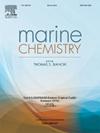西北太平洋沉积物中镍及其同位素对锰矿物差异富集的响应
IF 2.5
3区 地球科学
Q2 CHEMISTRY, MULTIDISCIPLINARY
引用次数: 0
摘要
镍(Ni)是海洋系统中的一种生物必需元素,但其海洋来源和汇仍未完全量化。微锰结核(MMNs)和微锰颗粒(MMPs)是海洋沉积物中主要的自生相,通过吸附或结合清除关键金属。这些矿物的富集在很大程度上取决于海水条件和沉积物内的成岩作用。不同锰相对多金属元素(特别是镍及其同位素)循环的影响虽具有重要意义,但却很少受到关注。本研究分析了西北太平洋含MMPs、MMNs和MMN沉积物的地球化学特征和Ni同位素特征。在JL190岩心中,MMNs显示出典型的亚氧成岩的Mn/Fe比值和微量元素模式。在所有三个岩心中,Ni浓度与Mn积累密切相关,如强Mn/Al - Ni/Al相关性所示。然而,马里亚纳海沟的TS01-B10岩芯含有富含硅藻的粘土,其相关性比菲律宾海的两个岩芯弱。总体沉积δ60Ni值较轻(0.01 ~ 0.79‰,中位数0.27‰),与大部分远洋沉积相一致。在B10岩心中,δ60Ni随Mn/Al比值的上升而下降,表明较轻的Ni同位素优先吸附。JL189中Mn/Al和δ60Ni同时增加,表明存在孔隙水交换和同位素分馏作用。相对于大块沉积物,成岩MMNs中较重的Ni同位素特征可能反映了长时间的孔隙水相互作用,从而保留了孔隙水的同位素特征。这些结果提供了MMNs的第一个δ60Ni数据,并阐明了它们作为Ni载体的作用。这些发现强调了自生Mn氧化物在影响重Ni同位素的底栖通量方面的重要性,这有助于平衡海洋Ni收支。本文章由计算机程序翻译,如有差异,请以英文原文为准。
Nickel and its isotope in response to differential manganese minerals accumulation in Northwest Pacific sediments
Nickel (Ni) is a biologically essential element in marine systems, yet its oceanic sources and sinks remain incompletely quantified. Micro manganese nodules (MMNs) and particles (MMPs) in marine sediment are major authigenic phase that scavenge critical metals though adsorption or incorporation. The accumulation of these minerals depends strongly on the seawater conditions and diagenetic processes within the sediments. Despite their significance, the influence of different manganese phase on the cycling of polymetallic elements-particularly Ni and its isotopes-has received little attention. This study analyzed MMPs bearing sediments, MMNs, and MMN bearing sediments from the Northwest Pacific Ocean to characterize their geochemical and Ni isotopic signatures. In core JL190, MMNs display Mn/Fe ratio and trace element patterns typical of suboxic-oxic diagenesis. Across all three cores, Ni concentrations track Mn accumulation closely, as shown by strong Mn/Al–Ni/Al correlations. However, core TS01-B10 from the Mariana Trench, which contains diatom-rich clay, yields weaker correlations than the two Philippine Sea cores. Despite these differences, bulk sediment δ60Ni values remain light (0.01–0.79 ‰, median 0.27 ‰), consistent with most pelagic sediments. In core B10, declining δ60Ni alongside rising Mn/Al ratios imply preferential adsorption of lighter Ni isotopes. In contrast, JL189 show simultaneous increase in Mn/Al and δ60Ni, suggesting porewater exchange and isotope fractionation on existing Mn oxides. The heavier Ni isotopic signature in diagenetic MMNs relative to bulk sediments likely reflects prolonged porewater interaction, preserving the porwater's isotopic signature. These results provide the first δ60Ni data for MMNs and elucidate their role as Ni carriers. These findings highlight the importance of authigenic Mn oxides in influencing the benthic flux of heavier Ni isotopes, which contributes to balancing the oceanic Ni budget.
求助全文
通过发布文献求助,成功后即可免费获取论文全文。
去求助
来源期刊

Marine Chemistry
化学-海洋学
CiteScore
6.00
自引率
3.30%
发文量
70
审稿时长
4.5 months
期刊介绍:
Marine Chemistry is an international medium for the publication of original studies and occasional reviews in the field of chemistry in the marine environment, with emphasis on the dynamic approach. The journal endeavours to cover all aspects, from chemical processes to theoretical and experimental work, and, by providing a central channel of communication, to speed the flow of information in this relatively new and rapidly expanding discipline.
 求助内容:
求助内容: 应助结果提醒方式:
应助结果提醒方式:


